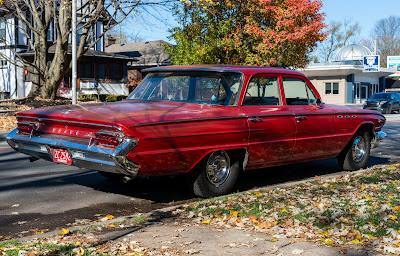For the 1961 model year, the full-size Buicks came in three different flavors. There was the top-of-the-line Electra, the middlin' Invicta, and the lower-spec LeSabre. The pecking order was signaled by the number of Ventiports on the fenders: The Electra got four, while Invicta and LeSabre owners could only flash three, which was the same number as on the new compact-size Special/Skylark models.
The LeSabre could be had as a hardtop coupe, hardtop sedan, two-door sedan, or as a four-door sedan like this Rio Red '61 parked on College Avenue the other morning.
Behind the chrome grille with its floating Tri-Shield badge was Buick's trusty 364 cubic inch "Nailhead" V-8, so-called because of the appearance of its valves, which had long stems and small heads.
The standard '61 LeSabre motor had a 2-barrel carburetor and a 10.25:1 compression ratio, necessitating premium fuel, and was rated at 250 SAE gross horsepower. A no-cost optional engine had a 9:1 compression ratio, allowing the use of regular fuel but dropping output to 235hp.
Alternatively, a LeSabre buyer could spend an extra $22 bucks to kick it up a notch with the Power Pack version of the 364, which had a 4-barrel Carter carb, dual exhausts, 11.25:1 compression, and 300 horses.
All three motors were backed by the 2-speed Turbine Drive (neé DynaFlow) automatic transmission. Well, we call it an automatic, but it didn't work the way we think of when we talk about modern slushboxes. If you drove it normally in "D", it stayed in the one gear all the time. The "L" ratio could only be selected manually, and if selected, it did not upshift by itself. The driving experience had more akin to a current CVT, at least aurally, than a typical modern automatic, as engine RPM & thus motor noise was governed as much by throttle position as road speed.
I wish I'd thought to get a picture of the dashboard, because this was one of the last years for the Mirromagic dash in full-size Buicks. The instrument panel lay flat in a cove atop the dash and was reflected into a mirror above it, the angle of which could be adjusted for best visibility to any driver's sightline.





